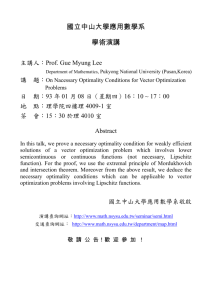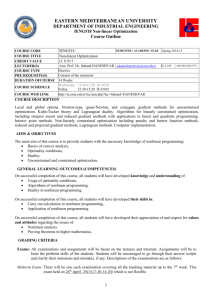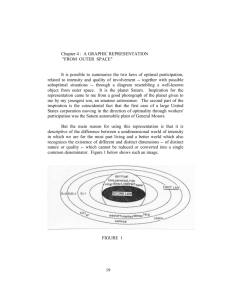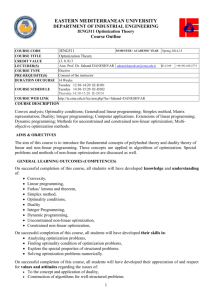OPTIMALITY CONDITIONS AND DUALITY THEOREMS FOR NONLIPSCHITZ OPTIMIZATION PROBLEMS
advertisement
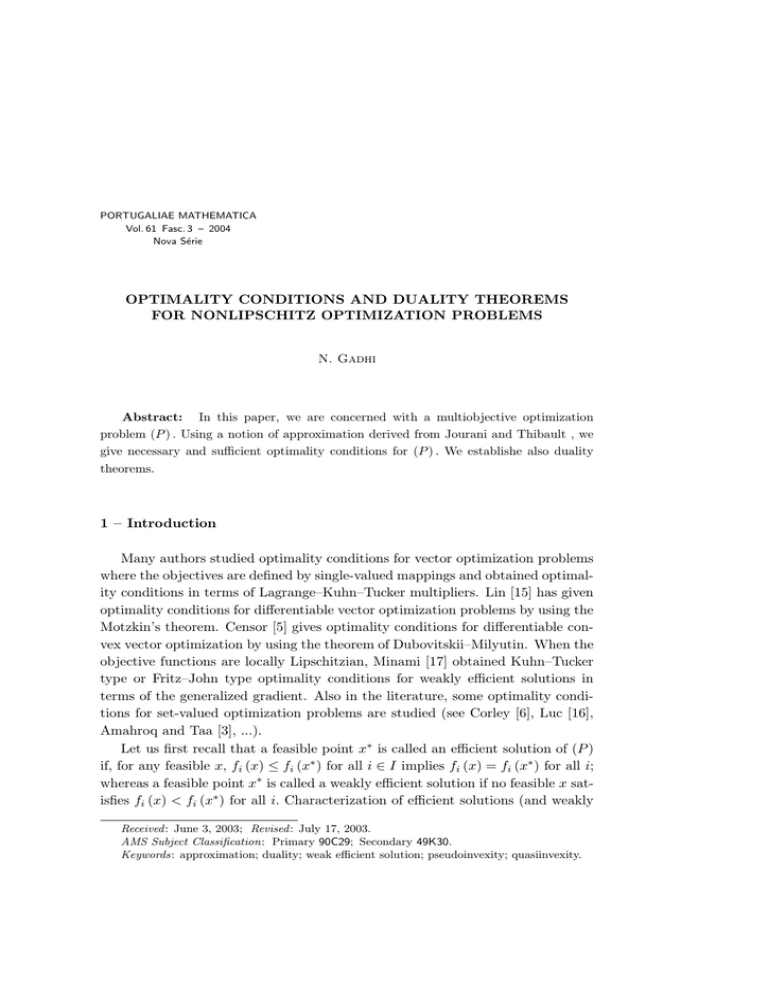
PORTUGALIAE MATHEMATICA
Vol. 61 Fasc. 3 – 2004
Nova Série
OPTIMALITY CONDITIONS AND DUALITY THEOREMS
FOR NONLIPSCHITZ OPTIMIZATION PROBLEMS
N. Gadhi
Abstract: In this paper, we are concerned with a multiobjective optimization
problem (P ) . Using a notion of approximation derived from Jourani and Thibault , we
give necessary and sufficient optimality conditions for (P ) . We establishe also duality
theorems.
1 – Introduction
Many authors studied optimality conditions for vector optimization problems
where the objectives are defined by single-valued mappings and obtained optimality conditions in terms of Lagrange–Kuhn–Tucker multipliers. Lin [15] has given
optimality conditions for differentiable vector optimization problems by using the
Motzkin’s theorem. Censor [5] gives optimality conditions for differentiable convex vector optimization by using the theorem of Dubovitskii–Milyutin. When the
objective functions are locally Lipschitzian, Minami [17] obtained Kuhn–Tucker
type or Fritz–John type optimality conditions for weakly efficient solutions in
terms of the generalized gradient. Also in the literature, some optimality conditions for set-valued optimization problems are studied (see Corley [6], Luc [16],
Amahroq and Taa [3], ...).
Let us first recall that a feasible point x∗ is called an efficient solution of (P )
if, for any feasible x, fi (x) ≤ fi (x∗ ) for all i ∈ I implies fi (x) = fi (x∗ ) for all i;
whereas a feasible point x∗ is called a weakly efficient solution if no feasible x satisfies fi (x) < fi (x∗ ) for all i. Characterization of efficient solutions (and weakly
Received : June 3, 2003; Revised : July 17, 2003.
AMS Subject Classification: Primary 90C29; Secondary 49K30.
Keywords: approximation; duality; weak efficient solution; pseudoinvexity; quasiinvexity.
318
N. GADHI
efficient solutions ) for a constrained multi-objective programming problem are of
practical interest, since multipliers associated with the dual optimality conditions
have useful economic interpretations, for instance in Welfare Economics [4].
Consider the following multi-objective nonsmooth programming problem
(P ) :
(
Min (f1 (x) , ..., fp (x))
subject to : gj (x) ≤ 0, j = 1, ..., m ,
where the functions fi and gj , defined on a Banach space X, i ∈ I = {1, ..., p},
j ∈ J = {1, ..., m} , admit approximations.
In general, problem (P ) is nonconvex and the Kuhn–Tucker optimality conditions (see Theorem 3.1) established by Amahroq and Gadhi [2] are only necessary.
Under what assumptions, are the Kuhn–Tucker conditions also sufficient for the
optimality of problem (P )? In [13], Kim and Lee considered the optimization
problem (P ) when the data are Locally Lipschitz. They give duality theorems
by using the concepts of pseudoinvexity and quasiinvexity.
In this note, we extend Kim and Lee’s findings by seeing if they are valid
for larger class of problems with ϕ = (f1 , ..., fp ) and g = (g1 , ..., gm ) admitting
approximations [1]. Based on necessary optimality conditions given by Amahroq
and Gadhi [2] (see Theorem 3.1), our approach consists of formulating the Mond–
Weir dual problem (D) and establishing duality theorems for (P ) and (D) without
any constraint qualification. We give also sufficient optimality conditions for (P ) .
Such a notion of approximation allows applications to continuous functions.
Note that for a continuous function, symmetric subdifferentials [19], upper semicontinuous convexificators [9], and upper semicontinuous approximate Jacobians
[10] are approximations. Naturally, for a locally Lipschitz function, most known
subdifferentials such as the subdifferentials of Clarke, Michel–Penot, Ioffe–Mordukhovich and Treiman can be chosen as approximations.
The outline of the paper is as follows: preliminary results are described in
Section 2; necessary and sufficient optimality conditions are given in Section 3;
Sections 4 is reserved for duality results.
2 – Preliminaries
Let X and Y be two Banach spaces. We denote by L (X, Y ) the set of continuous linear mappings between X and Y, BY the closed unit ball of Y centered at
the origin, SY the unit sphere of Y and X ∗ the continuous dual of X. We write
h., .i for the canonical bilinear form with respect to the duality hX ∗ , Xi .
319
OPTIMALITY CONDITIONS AND DUALITY
In all the sequel we will need the following definition. It was introduced for the
first time by Jourani and Thibault [12] and revised after by Allali and Amahroq
[1]. Here we adopt the latest definition of approximation [1].
Definition 2.1 ([1]). Let f be a mapping from X into Y, x ∈ X and Af (x) ⊂
L (X, Y ) . Af (x) is said to be an approximation of f at x if, for each ε > 0, there
exists δ > 0 such that
(2.1)
f (x) − f (x) ∈ Af (x) (x − x) + ε kx − xk BY
for all x ∈ x + δ BX .
It is easy to see that f + g has Af (x) + Ag (x) as an approximation at x
whenever Af (x) and Ag (x) are approximations of f and g at x.
Note that Af (x) is a singleton if and only if f is Fréchet differentiable at x.
In [1], it is shown that when f is a locally Lipschitz function, it admits as an
approximation the Clarke subdifferential of f at x; i.e.
n
o
Af (x) = ∂f (x) := cl co Lim ∇f (xn ) ; xn ∈ dom∇f and xn → x .
In order to give an example of non locally Lipschitz function, let us recall the
following definition.
Definition 2.2 ([19]). Let f : X → R := [−∞, +∞] be an extended-real-valued function and x ∈ dom(f ). The symmetric subdifferential of f at x is
defined by
∂ 0 f (x) := ∂f (x) t [−∂(−f ) (x)]
where ∂f (x) := lim sup ∂bε f (x) and ∂bε f (x) is the ε-Fréchet subdifferential of f
f
x→x, ε&0
at x. For more details see [19].
Note that sufficient conditions for the upper semicontinuity of ∂ 0 f (.) can be
found in [8] and [14]. It has been proved by Amahroq and Gadhi [2] that if f is
continuous then ∂ 0 f (x) is an approximation of f at x.
Remark 2.1. By a similar argument to that used in [1], Theorem 2.3 of [10]
(Mean value theorem) implies that the upper semicontinuous hull of an approximate Jacobian [10, 11],
n
o
−−−−→
∂ ∗ f (x) := ∂ ∗ f (x) ∪ M ∈ Rn×n : xk → x, Mk ∈ ∂ ∗ f (xk ) , Mk → M ,
is an approximation.
320
N. GADHI
Here, ∂ ∗ f (x) denotes the approximate Jacobian of f at x. For more details
on this notion, we refer the interested reader to [10, 11].
Let C := {x ∈ X : gj (x) ≤ 0, j = 1, ..., m} . Assuming that g admits an approximation at x, the following regularity condition is an adaptation of Amahroq
and Gadhi’s regularity [2] to our case.
Definition 2.3 ([2]). The problem (P ) is said to be regular at x ∈ C if there
exist a neighborhood U of x and δ, γ > 0 such that :
∀y ∗ ∈ [0, +∞[m , ∀x ∈ U, ∀x∗ ∈ Ag (x) , ∃ξ ∈ δ BX such that
hy ∗ , g (x)i + hy ∗ ◦ x∗ , ξi ≥ γ ky ∗ k .
For the rest of the paper ( Section 3 and Section 4 ), we suppose that X
is separable and that the functions fi , i = 1, ..., p, and gj , j = 1, ..., m, admit
approximations Afi (x) and Agj (x) at x. Moreover, the functions fi and gj are
assumed to have the following properties
w∗
• If x∗n ∈ µ∗n Agj (xn ) , where x∗n → x∗ in X ∗ , µ∗n → µ∗ in R and xn → x in X,
then x∗ ∈ µ∗ Agj (x).
• There exists δ > 0 such that for every x ∈ x + δ BX , the function fi admits
an approximation Afi (x) at x and Afi (x) is bounded w ∗ -closed.
• There exists δ > 0 such that for every x ∈ x + δ BX the function gj admits
an approximation Agj (x) at x.
• For each ε > 0 there exists δ > 0 such that for all x ∈ x + δ BX
Afi (x) ⊂ Afi (x) + ε BX ∗ .
• For each ε > 0 and for each µ∗n → µ∗ in [0, 1] there exist δ > 0 and n0 ∈ N
such that
µ∗n Agj (x) ⊂ µ∗ Agj (x) + ε BX ∗
for all n ≥ n0 and x ∈ x + δ BX .
3 – Necessary and sufficient optimality conditions
The following theorem is a direct consequence of Theorem 2 of [2]. It gives
necessary optimality conditions for the multi-objective optimization problem (P ) .
OPTIMALITY CONDITIONS AND DUALITY
321
Theorem 3.1 (Necessary optimality conditions). Suppose that x is an efficient ³solution of´ (P ) . Under the above regularity condition, there exist vectors
p∗ = λ∗1 , ..., λ∗p ∈ Rp , kp∗ k = 1 and y ∗ = (µ∗1 , ..., µ∗m ) ∈ Rm such that
(3.1)
0 ∈
p
X
λ∗i Afi (x) +
i=1
(3.2)
(3.3)
µ∗j Agj (x) ,
j=1
µ∗j gj (x) = 0, gj (x) ≤ 0
³
m
X
for any j = 1, ..., m ,
λ∗1 , ..., λ∗p , µ∗1 , ..., µ∗m
´
≥ 0.
Remark 3.1. With appropriate data, Zowe and Kurcyusz’s regularity [20]
implies the regularity of [2]. For more details, we refer the reader to [2].
To give sufficient optimality conditions, we shall need additional assumption
on the data. The definitions that we propose below are more comprehensive
than Giorgi and Guerraggio’s [7]; however, they are identical when the data are
Lipschitz and the Clarke’s subdifferential is taken as the approximation.
Definition 3.1. Suppose that a function g : X → R admit an approximation
Ag (x) ⊂ L (X, R) for all x ∈ X. Then:
1. Let η : X×X → X be a mapping; we say that g is (η, Ag )-pseudoinvex if
g (y) < g (x)
implies hξ, η (y, x)i < 0 ,
∀x, y ∈ X, ∀ξ ∈ Ag (x) .
2. Let η : X×X → X be a mapping; we say that g is (η, Ag )-quasiinvex if
g (y) ≤ g (x)
implies hξ, η (y, x)i ≤ 0 ,
∀x, y ∈ X, ∀ξ ∈ Ag (x) .
3. Let η : X×X → X be a mapping; we say that g is strictly (η, Ag )-pseudoinvex if
g (y) ≤ g (x) implies hξ, η (y, x)i < 0 ,
∀x, y ∈ X with x 6= y, ∀ξ ∈ Ag (x) .
322
N. GADHI
Theorem 3.2 (Sufficient optimality conditions). Let x ∈ C and suppose that
1. The functions fi are (η, Afi )-pseudoinvex for all i = 1, ..., p,
´
³
2. The functions gj are η, Agj -quasiinvex for all j = 1, ..., m,
3. It is true all the thesis of Theorem 3.1.
Then, x is a weakly efficient solution of (P ) .
Proof: By contradiction, suppose that x is not a weakly efficient solution of
(P ) . Then, there exists x ∈ X such that
³
´
f1 (x) − f1 (x) , ..., fp (x) − fp (x) ∈ − Int Rp ,
+
gj (x) ≤ 0
for all j = 1, ..., m .
Consequently, for every i ∈ {1, ..., p} ,
fi (x) − fi (x) < 0 .
On the one hand, from the (η, Afi )-pseudoinvexity of fi , we have
(3.4)
hξ, η (x, x)i < 0
for all ξ ∈ Afi (x) .
On the other hand, from hypothesis 3, there exist ai ∈ Afi (x) and bj ∈ Agj (x)
such that
³
´
∗ ≥ 0,
∗ , ..., λ∗ 6= 0 ,
λ
λ
p
1
i
(3.5)
p
X
λ∗i ai +
m
X
µ∗j bj = 0 .
j=1
i=1
Combining (3.4) and (3.5) ,
(3.6)
*
−
m
X
µ∗j bj
, η (x, x)
j=1
+
< 0.
Combining (3.2) and (3.3) , one has
³
´
µ∗j gj (x) − gj (x) ≤ 0 .
from the (η, Agj )-quasiinvexity of gj , we get
*
which is a contradiction.
m
X
j=1
µ∗j bj
, η (x, x)
+
≤ 0,
OPTIMALITY CONDITIONS AND DUALITY
323
4 – Duality Theorems
In this section, we suppose also that the functions fi , i = 1, ..., p, and gj ,
j = 1, ..., m, admit approximations Afi (x) and Agj (x) at every point x. Using
the necessary optimality conditions of Theorem 3.1, we formulate the Mond–Weir
dual problem (D) [18] and establish duality theorems for (P ) and (D) .
Consider the Mond–Weir dual problem (D) of (P ) ,
(D) :
s.t.
(4.1)
³
Max ϕ (v) = f1 (v) , ..., fp (v)
0 ∈
p
X
λ∗i Afi (v) +
i=1
(4.2)
(4.3)
³
m
X
´
µ∗j Agj (v) ,
j=1
µ∗j gj (v) ≥ 0,
´
for any j = 1, ..., m ,
λ∗1 , ..., λ∗p , µ∗1 , ..., µ∗m ≥ 0 ,
³
´
λ∗1 , ..., λ∗p 6= (0, ..., 0) .
Remark 4.1. In formulating (D) , we do not use the equality in (4.2).
Remark 4.2. In the hypotheses of Theorem 3.1, the set of feasible points of
(D) is nonempty.
In the following result, we establish weak duality relations between problems
(P ) and (D) . The argument is similar to that used by Kim and Lee in [13], but
we give the proof in a more general situation.
Theorem 4.1 (Weak Duality). Suppose that for all i³∈ {1, ´..., p} and j ∈
{1, ..., m}, fi is (η, Afi )-pseudoinvex and gj is strictly η, Agj -pseudoinvex.
Then, for any feasible point x of (P ) and any feasible point (v, λ, µ) of (D) ,
there exists s ∈ {1, ..., p} such that
fs (x) ≥ fs (v) .
Proof: By contrary, suppose that there exist a feasible point x of (P ) and a
feasible point (v, λ, µ) such that
fi (x) < fi (v)
for all i = 1, ..., p .
Remark that x 6= v. By the (η, Afi )-pseudoinvexity of fi , we get
(4.4)
hξi , η (x, v)i < 0
for all ξi ∈ Afi (v) , i = 1, ..., p .
324
N. GADHI
From (4.3) and (4.4) , it follows that
* p
X
(4.5)
λi ξi , η (x, v)
i=1
+
< 0.
Using relation (4.1) , (4.5) becomes
(4.6)
m
X
µj hζj , η (x, v)i > 0,
for suitable ζ1 ∈ Ag1 (v), ..., ζm ∈ Agm (v) .
j=1
Observe that µ = (µ1 , ..., µm ) 6= 0. (Otherwise, we get a contradiction with (4.6))
Now, let M = {j : µj > 0} . As a consequence of (4.2) , we have
gj (v) ≥ 0
for all j ∈ M .
Since gj (x) ≤ 0, one has
gj (x) ≤ gj (v)
for all j ∈ M .
From the strict (η, Agj )-pseudoinvexity of gj ,
hζj , η (x, v)i < 0
for all ζj ∈ Agj (v), j ∈ M .
By definition of M, µj = 0 for any j ∈
/ M. Thus,
(4.7)
m
X
j=1
µj hζj , η (x, v)i =
m
X
µj hζj , η (x, v)i < 0,
for all ζj ∈ Agj (v) .
j=1,j∈M
Combining (4.6) and (4.7) , we get a contradiction.
Theorem 4.1 and Theorem 4.2 are extensions of [13, Theorem 2.1] and
[13, Theorem 2.2] obtained for Lipschitz functions.
Theorem 4.2 (Strong Duality). Let x be a weakly efficient solution for (P )
such that (P ) is regular at x. Then, there exist λ∗ ∈ Rp and µ∗ ∈ Rm such that
(x, λ∗ , µ∗ ) is a feasible point of (D) and their objective values are equal. Moreover,
if fi is (η, Afi )-pseudoinvex and gj is strictly (η, Agj )-pseudoinvex, then (x, λ∗ , µ∗ )
is a weakly efficient solution of (D) .
325
OPTIMALITY CONDITIONS AND DUALITY
Proof: Let x∗ be a weakly efficient solution of (P ) . Let
h
i
ψ (x) = max fi (x) − fi (x) .
1≤i≤p
Then, following the approach of Minami [17], we can check easily that x is an
optimal solution of the following scalar optimization problem
Min ψ (x) ,
s.t. gj (x) ≤ 0, j = 1, ..., m .
From Corollary 1 in [2],
Aψ (x) =
( p
X
αi∗ ζi
:
(α1∗ , ..., αp∗ )
p
∈R ,
αi∗
≥ 0,
i=1
p
X
αi∗
= 1, ζi ∈ Afi (x)
i=1
)
is an approximation of ψ at x.
By Theorem 2 in [2], there exist τ ∗ > 0 and µ∗1 , ..., µ∗m ≥ 0 such that
(4.8)
0 ∈ τ ∗ Aψ (x) +
m
X
µ∗j Agj (x)
and
µ∗j gj (x) = 0, j = 1, ..., m .
j=1
³
´
Thus, there exists α1∗ , ..., αp∗ ∈ Rp such that αi∗ ≥ 0,
0 ∈
p
X
i=1
τ ∗ αi∗ Afi (x) +
m
X
µ∗j Agj (x)
and
p
P
i=1
αi∗ = 1, and
µ∗j gj (x) = 0, j = 1, ..., m .
j=1
Setting λ∗ = τ ∗ (α1∗ , ..., αp∗ ), we get that (x, λ∗ , µ∗ ) is a feasible point of (D) and
the objective values of (P ) and (D) are equal.
Now, suppose that fi is (η, Afi )-pseudoinvex and gj is strictly (η, Agj )-pseudoinvex. Then, from Theorem 4.1, for every feasible point (v, λ, µ) of (D) there
exists s ∈ {1, ..., p} such that
fs (x) ≥ fs (v) .
Finally, since (x, λ∗ , µ∗ ) is a feasible point of (D) , then it is a weakly efficient
solution of (D) . The proof is thus finished.
ACKNOWLEDGEMENT – The author wishes to thank the referee for his insightfull
suggestions.
326
N. GADHI
REFERENCES
[1] Allali, K. and Amahroq, T. – Second order approximations and primal and
dual necessary optimality conditions, Optimization, 40 (1997), 229–246.
[2] Amahroq, T. and Gadhi, N. – On the regularity condition for vector programming problems, Journal of Global Optimization, 21 (2001), 435–443.
[3] Amahroq, T. and Taa, A. – On Lagrange–Kuhn–Tucker multipliers for multiobjective optimization problems, Optimization, 41 (1997), 159–172.
[4] Arrow, K.J. – An extension of the basic theorems of classical welfare economics,
Proceeding of the Second Berkeley Symposium on Mathematical Statistics and Probability, University of California Press, Berkeley, Los Angeles (1951), 507–532.
[5] Censor, T. – Pareto optimality in multiobjective problems, Applied Mathematics
and Optimization, 4 (1977), 41–59.
[6] Corley, H.W. – Optimality conditions for maximization of set- valued functions,
Journal of Optimization Theory and Application, 58 (1988), 1–10.
[7] Giorgi, G. and Guerraggio, A. – The Notion of Invexity in Vector Optimization: Smooth and Nonsmooth Case, Generalized Convexity, Generalized Monotonicity: Recent Results (J.P. Crouzeix, J.E. Martinez-Legaz and M. Volle, Eds.),
Kluwer Academic Publishers, Dordrecht, Holland, (1998), 389–405.
[8] Ioffe, A.D. – Approximate subdifferential and applications, III: The metric theory, Mathematika, 36 (1989), 1–38.
[9] Jeyakumar, V. and Luc, D.T. – Nonsmooth calculus, minimality, and monotonicity of convexificators, Journal of Optimization Theory and Applications, 101
(1999), 599–621.
[10] Jeyakumar, V.; Luc, D.T. and Schaible, S. – Characterizations of generalized
monotone nonsmooth continuous maps using approximate Jacobians, Journal of
Convex analysis, 5 (1998), 119–132.
[11] Jeyakumar, V. and Tuan, H.D. – Approximate Jacobian based nonsmooth Newton methods: convergence analysis, To appear.
[12] Jourani, A. and Thibault, L. – Approximations and metric regularity in mathematical programming in Banach spaces, Math. Oper. Res., 18(41) (1988), 73–96.
[13] Kim, M.H. and Lee, G.M. – On duality theorems for nonsmooth Lipschitz optimization problems, Journal of Optimization Theory and Application, 110 (2001),
669–675.
[14] Loewen, P.D. – Limits of Fréchet normals in nonsmooth analysis, Optimization
and Nonlinear Analysis, Pitman Research Notes Math, Ser. 244 (1992), 178–188.
[15] Lin, J.G. – Maximal vectors and multiobjective optimization, Journal of Optimization Theory and Application, 18 (1976), 41–64.
[16] Luc, D.T. – Contingent derivatives of set-valued maps and applications to vector
optimization, Mathematical Programming, 50 (1991), 99–111.
[17] Minami, H. – Weak Pareto-optimal necessary conditions in a nondifferentiable
multiobjective program on Banach space, Journal of Optimization Theory and Application, 41 (1983), 451–461.
[18] Mond, B. and Weir, T. – Generalized concavity and duality, Generalized concavity in optimization and Economics (S. Shaible and W.T. Ziemba, Eds.), Academic
Press, New York, NY (1981), 263–279.
OPTIMALITY CONDITIONS AND DUALITY
327
[19] Mordukhovich, B.S. and Shao, Y. – On nonconvex subdifferential calculus in
Banach spaces, Journal of Convex Analysis, 2 (1/2) (1995), 211–227.
[20] Zowe, J. and Kurcyusz, S. – Regularity and stability for the mathematical
programming problem in Banach spaces, Applied Mathematics and Optimization,
5 (1979), 49–62.
N. Gadhi,
B.P. 3536, Amerchich, Marrakech – MOROCCO
E-mail: n.gadhi@ucam.ac.ma
ngadhi@math.net
